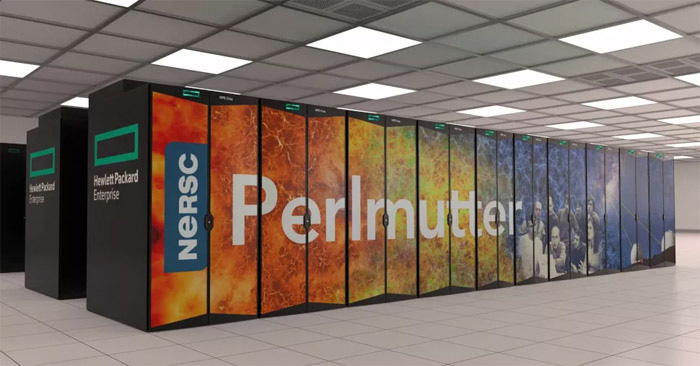Nvidia creates 3D universe map using the world's most powerful AI supercomputer
Nvidia unveiled a new supercomputer said to be the world's fastest for AI at the National Energy Research Science Computing Center (NERSC) in California.
This supercomputer is named after astrophysicist Saul Perlmutter. It was originally tasked with building the world's largest 3D map of the universe using over 6,000 Nvidia A100 Tensor Core GPUs onboard.

This supercomputer is named after astrophysicist Saul Perlmutter.
Currently, the Perlmutter supercomputer is capable of delivering almost 4 exaFLOPS of AI performance, making it 'the fastest system on the planet using mathematical AI based on 16- and 32-bit mixed-precision calculations', according to the report. Nvidia. Its performance will be further bolstered as part of 'phase two', with the introduction of a second group of CPU cores.
Once the system is complete, it is expected to be in the top five supercomputers in the Top 500 ranking, which measures overall performance using the High Performance Linpack (HPL) benchmark.
According to Nvidia, the Perlmutter system relies on contributions from more than 7,000 researchers. Besides, dozens of applications are also ready to 'present' in this project with the goal of promoting the development of astronomy and climate science.
'In one project, the supercomputer will help create the largest 3D map of the universe visible to date. It will process data from the Dark Energy Spectrometer (DESI), a space camera that can capture up to 5,000 galaxies in a single exposure,' said Dion Harris, Nvidia HPC&AI Product Marketing Lead, explain.
According to Harris, researchers needed Perlmutter's GPU speed to capture dozens of exposures in one night to know where DESI would be the next night. Preparing a year's data for publication would take weeks or months based on previous systems, but with Perlmutter this task will help scientists complete the task in just a few days.
It is hoped that once completed, the map of the universe will help researchers learn more about dark energy, the force behind the accelerating expansion of the universe. The discovery of dark energy in 2011 earned Saul Perlmutter the Nobel Prize.
Other projects set to run on the Perlmutter supercomputer have similarly ambitious goals. Some of them will use the unique characteristics of Tensor cores in the A100 to simulate interactions between atoms, which was not possible before.
This work could prove wonders in the field of materials science, by potentially uncovering more efficient ways of developing batteries, biofuels and the like.
- Nvidia's new AI creates incredibly fake fake videos
- China created the world's largest virtual universe with supercomputers
- China announced the world's most powerful supercomputer
- The world's most powerful new supercomputer
- 40 minutes only simulates 1 second of the human brain
- America is once again the country with the most powerful supercomputer in the world
- China leads the top 500 most powerful supercomputers in the world
- IBM will build the world's most powerful supercomputer
- Constructing successful virtual universe, did scientists come very close to the answer to the origin and expansion of the universe?
- China claims to own the world's most powerful quantum computer system
- Shock proof: Humans were born from the most terrible thing in the universe?
- Supercomputer simulates the evolution of the universe
 The world's first sexless AI voice
The world's first sexless AI voice This cool t-shirt will make you invisible to AI
This cool t-shirt will make you invisible to AI AI can predict personality only through selfie photos
AI can predict personality only through selfie photos The world-famous chess player lost to Golaxy before, artificial intelligence 'made in China'
The world-famous chess player lost to Golaxy before, artificial intelligence 'made in China' World's oldest trees reveal biggest solar storm in history
World's oldest trees reveal biggest solar storm in history  Cells in the body are constantly renewing themselves, why do people still age?
Cells in the body are constantly renewing themselves, why do people still age?  NASA captures strange details of giant 'tadpoles' in Siberia: Scientists immediately warn
NASA captures strange details of giant 'tadpoles' in Siberia: Scientists immediately warn  Đường hầm tuổi đời hàng thế kỷ được mở cửa
Đường hầm tuổi đời hàng thế kỷ được mở cửa  Điều gì sẽ tới khi Milk Way va chạm với Andromeda
Điều gì sẽ tới khi Milk Way va chạm với Andromeda  Khí cầu NASA khổng lồ chở kính viễn vọng lên cao 40.000 m
Khí cầu NASA khổng lồ chở kính viễn vọng lên cao 40.000 m 